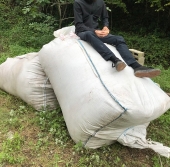Last year I started a reasonably sized (6'x6'x6") oyster mushroom patch. I recall reading that an outdoor patch that is 4-6 weeks old should be able to overwinter and continue producing in the spring. I looked at my patch the other day and noticed that it all seems to be mushroom
compost. This is still beneficial, but I was really hoping to keep the patch alive and help it to thrive this spring. I am starting another bed, so even if my old one doesn't produce a flush, my new one will. I would really appreciate some pointers on how to keep these outdoor fungi beds going.





